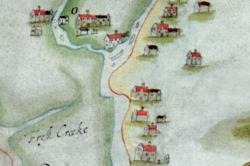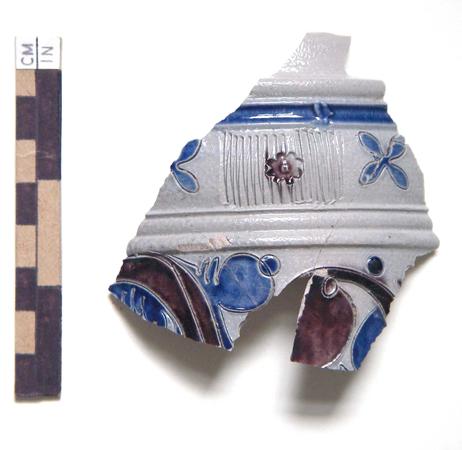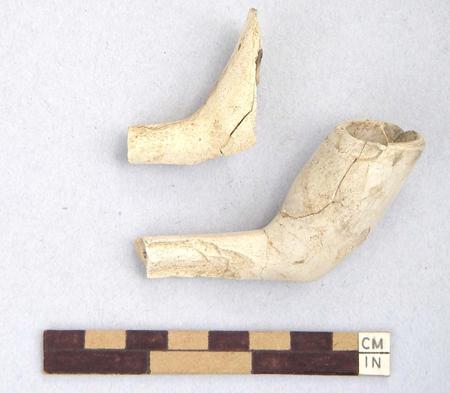Archaeologists Investigate 17th Century Settlement in South Berwick, Maine
Photos : Courtesy Old Fields Archaeology Project.
Source - http://popular-archaeology.com/issue/march-2012/article/archaeologists-investigate-17th-century-settlement-in-south-berwick-maine

Pascatway River map, c. 1665, excerpt. Courtesy Old Fields Archaeology Project.
It was the year 1693 and the two men were haying the fields near a garrison in colonial Maine when they were ambushed by a Wabanaki (American Indian) war party. One was killed. The other was scalped.
Just two years before, Wabanaki forces had attacked the garrison, but were successfully repulsed. King William's War (1689-97) typically saw scenes like this. The war became the first of six colonial wars fought between New France and New England, along with Native American allies, in the contested new frontier of North America before Britain eventually defeated France there in 1763.
Led by Dr. Neill de Paoli, archaeologists are now exploring and excavating the area of one of these 17th century garrisons and related homesteads, located near present-day South Berwick, Maine. Called the Old Fields Archaeology Project, they are focusing on the property of Harvey and Paula Bennett, the 18th century homestead of Captain Ichabod Goodwin (1700-1778) and his son, General Ichabod Goodwin (1743-1829). One of their goals is to determine whether this property was also the site of a “garrison” sheltering citizens during this era of warfare many years before. Before being owned by the Goodwins, the property was thought to have been occupied by William Spencer (c.1631 - 1696) and his nephew, Humphrey Spencer, from c. 1690 to c. 1712. As a garrison at that time, it and its associated fields were recurring targets of war parties of the Wabanaki Confederacy, allied with the French. The garrison sheltered as many as 100 residents and soldiers in 1711.
The first evidence of English occupation of the area indicates settlement in the 1660s and 1670s, but nearby water falls had been harnessed for sawmills since as early as 1634. Along the nearby Salmon Falls River, the settlers had established the Pipestave Landing, the settlement’s first primary docking facility for trade and commerce. And In the late 18th century the area became the site of the mansion of Jonathan Hamilton, a prominent merchant. The mansion still stands to this day.
Regarding its significance, the Project staff reports that "the Old Fields site is thus in the midst of important landings, mills, and early road junctions. It is surrounded by early landmarks, including what were once Wabanaki Indian corn fields (“Old Fields”); Cow Cove, reputed site of the 1634 landing of the English ship “Pied Cow”; the archaeological site of the Humphrey Chadbourne homestead (1654-1690); the 17th century Old Fields cemetery; and the settlement’s first meetinghouse (c.1660/1668)."[1] The area therefore represents a rich microcosm of life during those times in colonial Maine.
What has been found?
Beginning in 2010, the excavations have already unearthed solid evidence of a late 17th century and early 18th century presence on the Goodwin homestead. They have uncovered artifacts dating from c. 1650 to c. 1730, including sherds of German and English stoneware jugs, tankards, glass wine bottles, English clay smoking pipes, English delftware and Portuguese or Spanish majolica plates and bowls, as well as turned lead and glass quarrels to casement windows. Traces of early historic structures have been uncovered, including laid, shaped stones that may have been part of a foundation or steps for a 17th or 18th century building.
Evidence hasn't been limited to the late 17th and early 18th centuries. They have also uncovered artifacts dated to the 1740 - 1829 time period, including those associated with blacksmithing, a kitchen, parlor, bedrooms, barn, and a dairy. The finds include slag, fragments of plates, bowls, jugs, pots, mugs, tankards, cups and a spoon; a “smoker’s companion” used to light pipes; a bone hairbrush and comb; decorated shoe buckles; and common pins and a pair of small scissors.

Portion of the cellar, foundation, or steps to a late 17th/early 18th century structure.

Westerwald tankard, Old Fields, late 17th-early 18th c.

Clay tobacco pipes, c. 1680 (above left) and early-mid 18th century (below right).
De Paoli hopes to return to Old Fields during the summer of 2012 to continue the search for the early Spencer homesteads and garrisons. Individuals who might be interested in joining the efforts are invited to learn more about the site and the opportunities at the Old Fields Archaeology Project website.
[1] http://oldberwick.org/index.php?option=com_content&view=article&id=486&Itemid=280